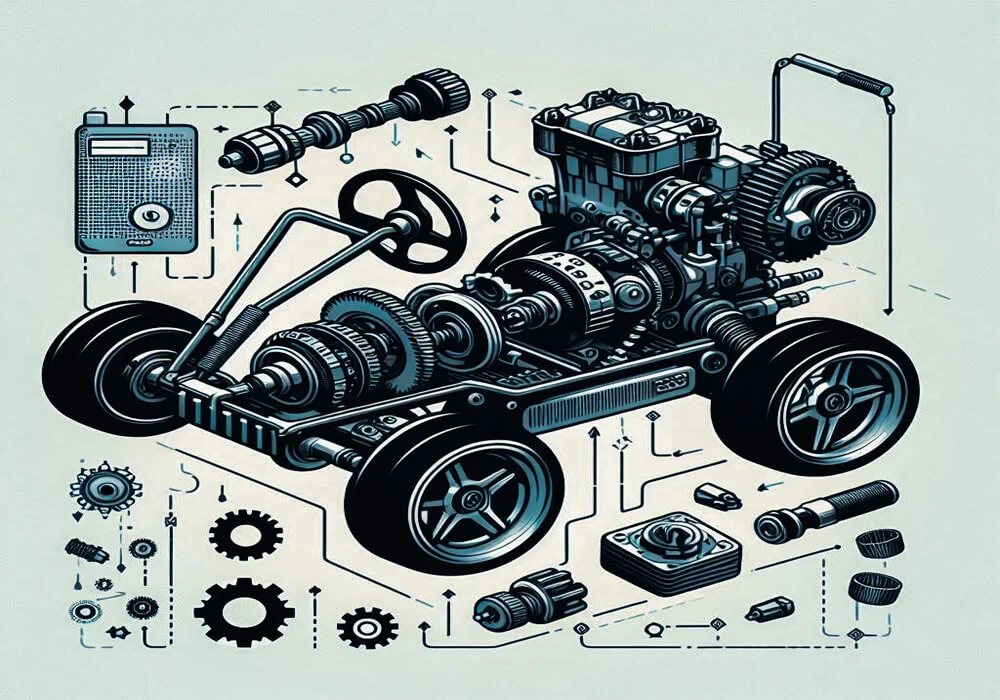Do Go Karts Have Gears?
Overview of Go-Kart Transmission Systems

The transmission system in a go-kart is crucial as it determines how power from the engine is transferred to the wheels. Go-karts generally come in three types of transmission systems: direct drive, automatic, and manual.
1. Direct Drive Go-Karts
Direct drive go-karts are the simplest form of go-karts. These karts do not have a traditional transmission system with gears. Instead, they rely on a direct connection between the engine and the wheels.
- Mechanics: In a direct drive system, the engine’s power is directly transmitted to the wheels through a chain or belt, resulting in a constant gear ratio.
- Usage: These go-karts are ideal for beginners and younger drivers due to their simplicity and ease of use.
- Performance: The speed is controlled solely by the accelerator and brake pedals, making them straightforward but less versatile in terms of speed and torque control.
2. Automatic Transmission Go-Karts
Automatic go-karts use a clutch or torque converter to manage the transmission without manual intervention.
- Mechanics: An automatic transmission go-kart typically features a centrifugal clutch that engages the drive belt as the engine’s RPM increases. Some may use a torque converter, which allows for smoother acceleration and better control at varying speeds.
- Usage: Popular for recreational use, these karts offer a user-friendly experience, making them suitable for casual drivers and rental go-kart tracks.
- Performance: They provide a smooth and consistent driving experience but lack the precise control over speed and acceleration that manual systems offer.
3. Manual Transmission Go-Karts (Shifter Karts)
Manual transmission go-karts, often referred to as shifter karts, are equipped with a gearbox that allows drivers to manually shift gears.
- Mechanics: These karts have a multi-speed gearbox (typically 6-speed) and a clutch, much like a motorcycle. The driver uses a hand clutch on the steering column and a shifter lever to change gears.
- Usage: Favored by professional racers and serious enthusiasts, shifter karts offer high performance and precise control.
- Performance: The ability to shift gears manually allows for optimal speed and torque control, making these karts suitable for competitive racing. They require more skill and experience to operate effectively.
Why the Type of Transmission Matters
The type of transmission in a go-kart significantly impacts its usability, performance, and suitability for different drivers.
1. Safety Considerations
- Direct Drive: The constant gear ratio in direct drive karts provides a predictable driving experience, which is safer for younger or inexperienced drivers.
- Automatic: With automatic transmission, drivers can focus more on steering and less on managing gears, reducing the likelihood of errors during operation.
- Manual: Shifter karts, while offering superior control, require greater skill and attention, making them better suited for experienced drivers. The manual shifting process can be complex and demanding.
2. Performance and Speed
- Direct Drive: Limited in performance due to the fixed gear ratio, suitable for low to moderate speeds.
- Automatic: Provides a balance of ease and performance, making it ideal for recreational use.
- Manual: Offers the best performance, with high speeds and acceleration capabilities, making them ideal for competitive racing scenarios.
Evolution of Go-Karts: From Simple Machines to Racing Beasts
Go-karts have evolved significantly since their inception. Originally simple, often homemade vehicles, modern go-karts have become sophisticated machines designed for high performance.
1. Early Days
In the early days, go-karts were basic motorized vehicles without much consideration for drivetrains or transmission systems. These were primarily used for casual fun and did not feature any advanced mechanisms.
2. Modern Go-Karts
With the growing popularity of karting, there has been a significant shift towards more advanced go-karts. Today, you can find karts with specialized transmission systems designed to meet various racing needs and driving experiences.
- Racing Innovations: The introduction of shifter karts has revolutionized competitive karting, allowing for greater speed control and higher performance.
- Recreational Improvements: Enhancements in automatic and direct drive systems have made go-karting more accessible and enjoyable for beginners and casual drivers.
Choosing the Right Go-Kart
Selecting the right go-kart depends on the intended use and the driver’s experience level.
- Beginners and Young Drivers: Direct drive or automatic go-karts are ideal due to their simplicity and safety.
- Casual and Recreational Use: Automatic go-karts offer a good balance of ease and performance.
- Competitive Racing: Shifter karts with manual transmission are best suited for those seeking high performance and precise control.
FAQs
What are the benefits of a direct drive transmission in go-karts for beginners?
A direct drive transmission is straightforward and easy to manage, especially for beginners. With no gears to shift, the driver can focus on steering and speed control. This simplicity reduces the chances of mechanical complications and offers a smoother ride, making it ideal for those new to go-karting.
How does a torque converter function in go-karts with automatic transmission?
In go-karts with automatic transmission, the torque converter remains disengaged when idling, allowing the engine to run without moving the kart. As the engine’s RPM surpasses roughly 1,500, the driver pulley begins to grip the belt, subsequently engaging the driven pulley and propelling the go-kart forward.
Are there specific brands known for producing reliable go-kart transmissions?
Yes, several brands are renowned for their go-kart transmissions. While the best brand can vary based on personal preferences and specific needs, it’s always advisable to research and consult reviews or experts before making a purchase.
For those interested in competitive racing, is a manual transmission preferable?
For competitive racers, a manual or “shifter” transmission is often preferred. It offers more control over speed and acceleration, allowing racers to optimize their performance on the track. Additionally, the ability to shift gears manually can provide an edge in races, especially when precise speed adjustments are crucial.
By understanding these aspects of go-kart transmissions, you can make an informed decision that best suits your driving style and goals. Whether you’re racing to win or just looking to have some fun, knowing how your go-kart’s transmission works will enhance your overall experience.
Conclusion
So, do go-karts have gears? The answer varies depending on the type of go-kart. While many recreational go-karts use automatic or gearless systems, high-end models designed for professional racing feature manual transmissions. Understanding the different transmission systems can help you choose the right go-kart for your needs, ensuring both safety and enjoyment.
Whether you are a beginner looking for a fun and safe ride or a competitive racer seeking the thrill of high performance, there is a go-kart with the right transmission system for you. Happy karting!

Jason Berry is a passionate enthusiast of all things go-karting. With years of experience in the industry, he has dedicated himself to exploring and uncovering the world of go-karts, from the adrenaline-pumping races to the intricacies of design and performance. Jason’s expertise extends beyond just the tracks; he delves into the mechanics, the technology, and the community that surrounds these thrilling machines. Through his articles and insights, Jason aims to share his knowledge and help fellow enthusiasts make informed decisions about their go-karting adventures. Whether you’re a seasoned racer or a newcomer to the sport, Jason’s expertise and passion are sure to rev up your excitement for the best go-karts on the market.

